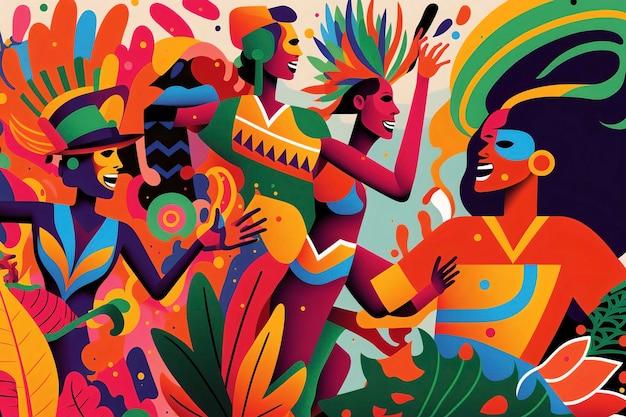Art is a reflection of the society we live in, capturing its essence, beliefs, and values. Throughout history, various cultures have left an indelible mark on the world of art, shaping and influencing its evolution. From the ancient civilizations of Egypt and Greece to the vibrant cultures of India and China, every society has contributed its unique artistic heritage.
In this blog post, we will explore the significant impact that different cultures have had on art. We will delve into how culture influences art and how art, in turn, influences society. Additionally, we will examine the values of art in education and practical life, as well as its influence on our daily lives.
Join us on this journey as we explore the vast tapestry of art and discover the cultures that have shaped our artistic landscape. Step into a world without boundaries, where creativity knows no limits, and let us appreciate the rich heritage that art offers us.

What cultures have had a major influence on the arts?
When it comes to the arts, it’s difficult to pinpoint just one culture that has had a major influence. Throughout history, various cultures have contributed to the development and evolution of artistic expression in their own unique ways. Let’s take a closer look at some of these influential cultures.
Ancient Greece: The Birthplace of Western Art
Ancient Greece is often considered the birthplace of Western art. From architecture to sculpture, the Greeks made significant contributions that continue to inspire artists today. The concept of idealized beauty and harmony, embodied in famous sculptures such as the Venus de Milo and the Discus Thrower, originated during this period.
Renaissance Italy: Reviving Classical Art
The Renaissance period in Italy was a game-changer for art. Artists like Leonardo da Vinci, Michelangelo, and Raphael pushed the boundaries of creativity and technical mastery. Inspired by the classical art of ancient Greece and Rome, they brought new life to painting, sculpture, and architecture.
Medieval Islamic Art: A Fusion of Cultures
Medieval Islamic art was a vibrant fusion of various influences, including Arab, Byzantine, Persian, and Indian. Intricate geometric patterns, calligraphy, and beautiful tilework are hallmarks of this art form. The Alhambra in Spain and the Taj Mahal in India are prime examples of the stunning architecture that emerged from this culture.
Japanese Edo Period: From Samurai to Ukiyo-e
During the Edo period in Japan, a time of relative peace, art flourished. Ukiyo-e, a genre of woodblock prints, gained popularity during this time. Artists like Hokusai and Hiroshige captured scenes of everyday life, landscapes, and famous actors, influencing Western artists like Monet and Van Gogh in the process.
20th Century America: From Pop to Hip Hop
In the 20th century, American culture had a significant impact on the arts. From pop art with its bold and colorful imagery, spearheaded by artists like Andy Warhol, to the rise of hip hop as a form of artistic expression, American artists continually pushed boundaries and challenged conventions.
Art is a reflection of the diversity and richness of human culture. From the ancient Greeks to modern-day America, the arts have been influenced by a multitude of cultures. Each one has contributed its own unique perspectives, techniques, and styles, shaping the artistic landscape we know today. So, let’s celebrate and appreciate the wonderful tapestry of artistic influences that have enriched our lives throughout history and continue to inspire us in the present day.

FAQ: What Cultures Have had Major Influences on Art?
How Does Culture Influence Art
Culture has a profound impact on art, shaping its forms, styles, and themes. Art reflects the beliefs, values, traditions, and customs of a particular culture. Whether it’s the vibrant and rhythmic dances of the African culture, the intricately detailed calligraphy of the Middle East, or the minimalistic elegance of Japanese design, art serves as a reflection of the cultural identity it emerges from. Cultural influences can be seen in the choice of materials, subject matter, techniques, and even the emotions conveyed in a work of art.
How Does Art Influence Society
Art has an incredible power to influence society. It can challenge the status quo, spark conversations, and change people’s perspectives. Art can inspire empathy, provoke thought, and promote social change. It can serve as a form of protest, shedding light on social injustices and giving a voice to marginalized communities. Art can also foster unity and bring people together, celebrating diversity and promoting inclusivity. Whether it’s a thought-provoking painting, a powerful piece of music, or a captivating dance performance, art has the potential to shape society in profound ways.
Does Art Improve School Performance
Yes, art has been shown to improve school performance in various ways. Engaging in the arts stimulates cognitive and creative thinking, which can enhance problem-solving skills and critical thinking abilities. Students who participate in art programs often exhibit improved concentration, better memory retention, and enhanced communication skills. Art also encourages self-expression and self-confidence, allowing students to discover and develop their unique talents and abilities. By fostering a positive and supportive learning environment, art can contribute to overall academic success and personal growth.
What Are the Values of Arts in Education and Practical Life
The value of arts in education extends far beyond the classroom. Art promotes creativity, imagination, and innovation, essential skills for success in practical life. It encourages individuals to think outside the box, find new perspectives, and explore unconventional ideas. Art also fosters cultural appreciation and empathy, helping individuals to better understand and connect with people from diverse backgrounds. Moreover, the arts provide an outlet for emotional expression, promoting mental well-being and stress relief. Whether pursuing a career in the arts or not, the values gained from art education can have a lifelong impact.
How Does Art Influence Our Daily Lives
Art is all around us, and its influence can be felt in our daily lives in countless ways. From the moment we wake up in the morning, we are surrounded by art in our homes, on the streets, and in our workplaces. Whether it’s the design of our furniture, the visual appeal of advertisements, the melodies we listen to, or the captivating performances we watch, art adds beauty, meaning, and enjoyment to our everyday experiences. Art has the power to evoke emotions, inspire creativity, and provide a source of inspiration and solace during challenging times. It enriches our lives and enhances the human experience in profound and often unexpected ways.
What Cultures Have Had Major Influences on Art
Numerous cultures have left indelible marks on the world of art. Some notable examples include:
-
Ancient Greece: The Greeks revolutionized art with their emphasis on realism, balance, and harmony. Their sculptures and architectural designs continue to inspire artists to this day.
-
Renaissance Italy: The Italian Renaissance brought about a surge of artistic innovation and achievement. Artists like Leonardo da Vinci and Michelangelo introduced new techniques and perspectives that laid the foundation for Western art.
-
Islamic Art: Islamic art is renowned for its intricate geometric patterns, calligraphy, and vibrant colors. It has significantly influenced architecture, ceramics, textiles, and decorative arts across various regions.
-
Impressionism in France: The Impressionist movement, led by artists such as Claude Monet and Edgar Degas, challenged traditional artistic conventions and focused on capturing fleeting moments of light and atmosphere.
-
Japanese Art: The aesthetics of Japanese art, characterized by simplicity, harmony, and nature-inspired motifs, have had a significant impact on various art forms, including painting, printmaking, ceramics, and garden design.
What Would a World Without Art Look Like
A world without art would be a dull and lifeless place. Art brings color, vibrancy, and meaning to our lives. It encompasses not only the visual arts but also music, literature, theater, and dance. Imagine a world without inspiring paintings, captivating novels, soul-stirring melodies, or awe-inspiring performances. There would be a void where creativity, expression, and cultural exchange once thrived. Art has the power to ignite our imagination, challenge our perspectives, and connect us on a deeper level. It sparks joy and beauty, allowing us to explore the depths of human emotions and experiences. Without art, our world would be devoid of one of humanity’s greatest forms of self-expression and connection.
What Is the Most Important Thing in Art
While art encompasses a vast array of forms, styles, and purposes, one could argue that its most important aspect is the emotional connection it evokes. Art has the power to stir feelings within us, whether it’s a sense of awe, joy, melancholy, or introspection. It has the ability to transcend language barriers and cultural boundaries, speaking directly to our hearts and souls. Art has the capacity to inspire, provoke, and touch us in profound ways. Ultimately, it is the emotional resonance that art elicits that makes it such a vital and cherished part of our lives.
What Are the Values of Arts in Our Lives
The values of art in our lives are manifold. Art provides us with an avenue for self-expression and reflection, allowing us to explore our thoughts, emotions, and experiences. It encourages us to think critically, question the status quo, and expand our perspectives. Art fosters creativity, imagination, and innovation, offering a space for experimentation and pushing boundaries. It also serves as a powerful tool for cultural preservation, showcasing the richness and diversity of human heritage. Furthermore, art has therapeutic qualities, promoting mental well-being, reducing stress, and creating a sense of connection and belonging. The values of art go far beyond its aesthetic appeal, enriching our lives in multifaceted ways.
How Does Art Improve Academic Performance
Art has been shown to have a positive impact on academic performance across various subjects. Engaging in the arts enhances cognitive abilities, such as critical thinking, problem-solving, and spatial reasoning skills. Art also stimulates creativity and encourages students to think outside the box, leading to innovative approaches in both artistic and academic pursuits. Moreover, participating in art activities can improve communication skills, self-confidence, and teamwork, essential qualities for success in the academic setting. By providing a holistic and well-rounded education, art can contribute to improved academic performance and a more comprehensive understanding of various subjects.
Note: This blog post was generated using AI.
